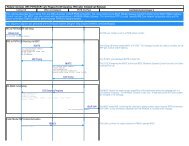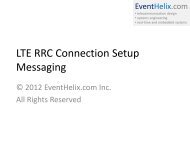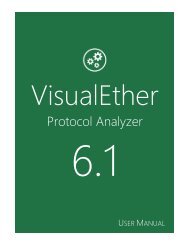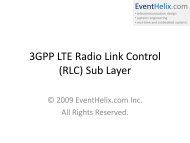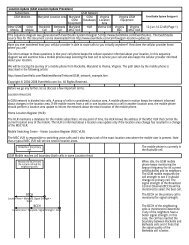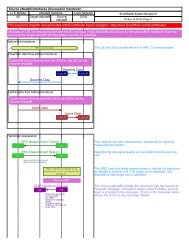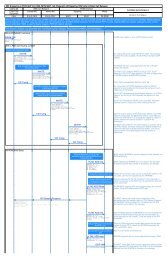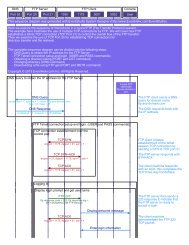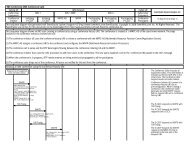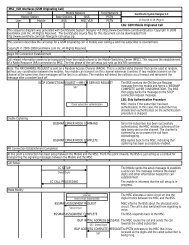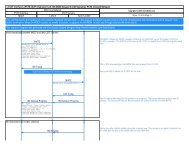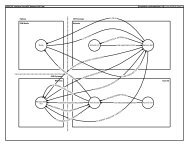IMS to PSTN Call Flow - EventHelix.com
IMS to PSTN Call Flow - EventHelix.com
IMS to PSTN Call Flow - EventHelix.com
You also want an ePaper? Increase the reach of your titles
YUMPU automatically turns print PDFs into web optimized ePapers that Google loves.
<strong>IMS</strong> Originating <strong>to</strong> <strong>PSTN</strong> ISUP <strong>Call</strong> (<strong>IMS</strong>-<strong>PSTN</strong>(ISUP) <strong>Call</strong>; Megaco/H.248 Signaling; <strong>IMS</strong> <strong>Call</strong>er Initiated <strong>Call</strong> Release)<strong>Call</strong>ing UE <strong>IMS</strong> Core Network <strong>PSTN</strong> Interface<strong>Call</strong>er User Equipment Visited <strong>IMS</strong> Home <strong>IMS</strong> Signaling Media<strong>Call</strong>er Orig P-CSCF Orig S-CSCF BGCF MGCF IM-MGWEventStudio System Designer 624-Feb-13 15:23 (Page 1)This call flow describes the call setup from one <strong>IMS</strong> subscriber <strong>to</strong> ISUP <strong>PSTN</strong> termination. The call is routed via the BGCF (Border Gateway Control Function) <strong>to</strong> the MGCF (Media GatewayControl Function). The MGCF uses one context with two terminations in IM-MGW (Media Gateway). The termination RTP1 is used <strong>to</strong>wards <strong>IMS</strong> Core network subsystem entity and thebearer termination TDM1 is used for bearer <strong>to</strong>wards <strong>PSTN</strong> CS network element.This sequence diagram was generated with EventStudio System Designer (http://www.<strong>EventHelix</strong>.<strong>com</strong>/EventStudio).<strong>IMS</strong> <strong>to</strong> <strong>PSTN</strong>(ISUP) call setupInitiate <strong>Call</strong><strong>Call</strong>ed <strong>PSTN</strong> TelephoneNumberAn <strong>IMS</strong> user initiates a call <strong>to</strong> a <strong>PSTN</strong> phonenumber.<strong>IMS</strong> <strong>to</strong> <strong>PSTN</strong> <strong>Call</strong> Routing via BGCFPrepare a list of supported codecsINVITEtel:,caller@hims1.net,caller supported coded list,UE RTP Port,UE IP AddressMake sure INVITE was received over IPSec SecurityAssociationINVITEtel:,caller@hims1.net,caller supported coded list,Record-Route:The <strong>Call</strong>ing SIP phone sends INVITE <strong>to</strong> P-CSCF. Themessage includes the codecs available, the UE RTPport number and IP address.The INVITE was sent using registration time SA soP-CSCF accepts the request.The Orig P-CSCF forwards INVITE <strong>to</strong> Orig S-CSCF.The IP Address of Orig S-CSCF was obtained at thetime of Registration in 200 OK response <strong>to</strong>REGISTER message.100 Trying Orig P-CSCF acknowledges INVITE <strong>to</strong> <strong>Call</strong>er UE.Use DNS <strong>to</strong> translate tel: <strong>to</strong>terminating SIP URI.Route session request <strong>to</strong> Breakout Gateway ControlFunction in the same networkINVITEtel:,S-CSCF address,
<strong>IMS</strong> Originating <strong>to</strong> <strong>PSTN</strong> ISUP <strong>Call</strong> (<strong>IMS</strong>-<strong>PSTN</strong>(ISUP) <strong>Call</strong>; Megaco/H.248 Signaling; <strong>IMS</strong> <strong>Call</strong>er Initiated <strong>Call</strong> Release)<strong>Call</strong>ing UE <strong>IMS</strong> Core Network <strong>PSTN</strong> Interface<strong>Call</strong>er User Equipment Visited <strong>IMS</strong> Home <strong>IMS</strong> Signaling Media<strong>Call</strong>er Orig P-CSCF Orig S-CSCF BGCF MGCF IM-MGWINVITEtel:,S-CSCF address,
<strong>IMS</strong> Originating <strong>to</strong> <strong>PSTN</strong> ISUP <strong>Call</strong> (<strong>IMS</strong>-<strong>PSTN</strong>(ISUP) <strong>Call</strong>; Megaco/H.248 Signaling; <strong>IMS</strong> <strong>Call</strong>er Initiated <strong>Call</strong> Release)<strong>Call</strong>ing UE <strong>IMS</strong> Core Network <strong>PSTN</strong> Interface<strong>Call</strong>er User Equipment Visited <strong>IMS</strong> Home <strong>IMS</strong> Signaling Media<strong>Call</strong>er Orig P-CSCF Orig S-CSCF BGCF MGCF IM-MGWChange TDM Through Connection =bothH.248: ADD.respContext ID = C1,Termination ID = TDM1ISUP IAMtel:EventStudio System Designer 624-Feb-13 15:23 (Page 3)Mark this connection as bidirectional.IM-MGW responds with the circuit switchedtermination TDM1.The MGCF sends IAM, containing the called partyphone number digits, <strong>to</strong>wards <strong>PSTN</strong> termination.The TDM-1 circuit information obtained from theIM-MGW is included in the message.<strong>Call</strong>er Media PDP Context ActivationSelect the Codec indicated in 183Session ProgressSelected CodecPRACKThe <strong>Call</strong>er confirms the codec selection in PRACK<strong>to</strong>wards MGCF.begin<strong>Call</strong>er PDP Context ActivationH.248: MOD.reqContext = C1,Termination = RTP1,Selected CodecThe MGCF modifies the IM-MGW context <strong>to</strong> updatethe IM-MGW about the codec selected for the RTPsession.Configure <strong>IMS</strong> resourcesH.248: MOD.respContext = C1,Termination = RTP1IM-MGW responds back.Selected Codec,Selected UDP Port,Selected IP Address200 OK (PRACK)The codec selected is acknowledged <strong>to</strong> the UE.end<strong>Call</strong>er PDP Context ActivationUPDATESince caller PDP Context Activation is over, notifythe called end in UPDATE message.200 OK (UPDATE) The called end replies back with 200 OK.
<strong>IMS</strong> Originating <strong>to</strong> <strong>PSTN</strong> ISUP <strong>Call</strong> (<strong>IMS</strong>-<strong>PSTN</strong>(ISUP) <strong>Call</strong>; Megaco/H.248 Signaling; <strong>IMS</strong> <strong>Call</strong>er Initiated <strong>Call</strong> Release)<strong>Call</strong>ing UE <strong>IMS</strong> Core Network <strong>PSTN</strong> Interface<strong>Call</strong>er User Equipment Visited <strong>IMS</strong> Home <strong>IMS</strong> Signaling Media<strong>Call</strong>er Orig P-CSCF Orig S-CSCF BGCF MGCF IM-MGWH.248: MOD.respContext ID = C1,Termination ID = TDM1EventStudio System Designer 624-Feb-13 15:23 (Page 5)200 OK (INVITE) The final response, 200 OK, is sent by the MGCFover the signaling path when the subscriber hasaccepted the in<strong>com</strong>ing session attempt.ACKThe <strong>Call</strong>er sends the final acknowledgement in ACKmessage <strong>to</strong>wards MGCF.VoiceRTP: VoiceVoiceBidirectional voice path is now through. TheIM-MGW converts RTP <strong>to</strong> voice and vice versa. UEalso maps audio <strong>to</strong> RTP and back.BYEThe <strong>Call</strong>er sends BYE <strong>to</strong>wards MGCF when thecalling party hangs up.Drop media PDP context200 OK (BYE) The MGCF acknowledges with 200 OK message<strong>to</strong>wards <strong>Call</strong>er.Release <strong>IMS</strong> TerminationISUP RELThe MGCF initiates call release in the <strong>PSTN</strong> networkby sending ISUP REL message.MGCF requests IM-MGW <strong>to</strong> release RTP1 resource.H.248: SUB.reqContext ID = C1,Termination ID = RTP1H.248: SUB.respContext ID = C1,Termination ID = RTP1Release TDM TerminationMGCF requests IM-MGW <strong>to</strong> release TDM1 resource.H.248: SUB.reqContext ID = C1,Termination ID = TDM1H.248: SUB.respContext ID = C1,Termination ID = TDM1ISUP RLCThe <strong>PSTN</strong> network acknowledges the call releasewith ISUP RLC, release <strong>com</strong>plete <strong>to</strong>wards MGCF.
<strong>IMS</strong> Originating <strong>to</strong> <strong>PSTN</strong> ISUP <strong>Call</strong> (<strong>IMS</strong>-<strong>PSTN</strong>(ISUP) <strong>Call</strong>; Megaco/H.248 Signaling; <strong>IMS</strong> <strong>Call</strong>er Initiated <strong>Call</strong> Release)<strong>Call</strong>ing UE <strong>IMS</strong> Core Network <strong>PSTN</strong> Interface<strong>Call</strong>er User Equipment Visited <strong>IMS</strong> Home <strong>IMS</strong> Signaling Media<strong>Call</strong>er Orig P-CSCF Orig S-CSCF BGCF MGCF IM-MGWThis sequence diagram was generated with EventStudio System Designer (http://www.<strong>EventHelix</strong>.<strong>com</strong>/EventStudio).EventStudio System Designer 624-Feb-13 15:23 (Page 6)
<strong>IMS</strong> Originating <strong>to</strong> <strong>PSTN</strong> ISUP <strong>Call</strong> (<strong>Call</strong>ed <strong>PSTN</strong> Subscriber Initiates Release)<strong>Call</strong>ing UE <strong>IMS</strong> Core Network <strong>PSTN</strong> Interface<strong>Call</strong>er User Equipment Visited <strong>IMS</strong> Home <strong>IMS</strong> Signaling Media<strong>Call</strong>er Orig P-CSCF Orig S-CSCF BGCF MGCF IM-MGWEventStudio System Designer 624-Feb-13 15:23 (Page 7)This call flow describes the call setup from one <strong>IMS</strong> subscriber <strong>to</strong> ISUP <strong>PSTN</strong> termination. The call is routed via the BGCF (Border Gateway Control Function) <strong>to</strong> the MGCF (Media GatewayControl Function). The MGCF uses one context with two terminations in IM-MGW (Media Gateway). The termination RTP1 is used <strong>to</strong>wards <strong>IMS</strong> Core network subsystem entity and thebearer termination TDM1 is used for bearer <strong>to</strong>wards <strong>PSTN</strong> CS network element.This sequence diagram was generated with EventStudio System Designer (http://www.<strong>EventHelix</strong>.<strong>com</strong>/EventStudio).<strong>IMS</strong> <strong>to</strong> <strong>PSTN</strong>(ISUP) call setupVoiceRTP: VoiceVoiceBidirectional voice path is now through. TheIM-MGW converts RTP <strong>to</strong> voice and vice versa. UEalso maps audio <strong>to</strong> RTP and back.ISUP RELThe call release initiated in the <strong>PSTN</strong> network isreceived by MGCF is ISUP REL message.BYEThe MGCF responds with call release by sendingBYE message <strong>to</strong>wards the <strong>Call</strong>er.Release <strong>IMS</strong> TerminationMGCF requests IM-MGW <strong>to</strong> release RTP1 resource.H.248: SUB.reqContext ID = C1,Termination ID = RTP1H.248: SUB.respContext ID = C1,Termination ID = RTP1Release TDM TerminationMGCF requests IM-MGW <strong>to</strong> release TDM1 resource.H.248: SUB.reqContext ID = C1,Termination ID = TDM1H.248: SUB.respContext ID = C1,Termination ID = TDM1ISUP RLCAfter performing RTP1 and TDM1 resource release,MGCF sends release <strong>com</strong>plete message, ISUP RLC<strong>to</strong>wards the <strong>PSTN</strong> network.Drop media PDP context200 OK (BYE) The <strong>Call</strong>er acknowledges the BYE by sending 200OK <strong>to</strong>wards MGCF.This sequence diagram was generated with EventStudio System Designer (http://www.<strong>EventHelix</strong>.<strong>com</strong>/EventStudio).
<strong>IMS</strong> Originating <strong>to</strong> <strong>PSTN</strong> ISUP <strong>Call</strong> (MGCF Initiated <strong>Call</strong> Release)<strong>Call</strong>ing UE <strong>IMS</strong> Core Network <strong>PSTN</strong> Interface<strong>Call</strong>er User Equipment Visited <strong>IMS</strong> Home <strong>IMS</strong> Signaling Media<strong>Call</strong>er Orig P-CSCF Orig S-CSCF BGCF MGCF IM-MGWEventStudio System Designer 624-Feb-13 15:23 (Page 9)This call flow describes the call setup from one <strong>IMS</strong> subscriber <strong>to</strong> ISUP <strong>PSTN</strong> termination. The call is routed via the BGCF (Border Gateway Control Function) <strong>to</strong> the MGCF (Media GatewayControl Function). The MGCF uses one context with two terminations in IM-MGW (Media Gateway). The termination RTP1 is used <strong>to</strong>wards <strong>IMS</strong> Core network subsystem entity and thebearer termination TDM1 is used for bearer <strong>to</strong>wards <strong>PSTN</strong> CS network element.This sequence diagram was generated with EventStudio System Designer (http://www.<strong>EventHelix</strong>.<strong>com</strong>/EventStudio).<strong>IMS</strong> <strong>to</strong> <strong>PSTN</strong>(ISUP) call setupVoiceRTP: VoiceVoiceBidirectional voice path is now through. TheIM-MGW converts RTP <strong>to</strong> voice and vice versa. UEalso maps audio <strong>to</strong> RTP and back.BYEThe MGCF initiates the call release by sending BYE<strong>to</strong>wards the <strong>Call</strong>er.Release <strong>IMS</strong> TerminationISUP RELThe MGCF initiates call release in the <strong>PSTN</strong> networkby sending ISUP REL message.MGCF requests IM-MGW <strong>to</strong> release RTP1 resource.H.248: SUB.reqContext ID = C1,Termination ID = RTP1H.248: SUB.respContext ID = C1,Termination ID = RTP1Release TDM TerminationMGCF requests IM-MGW <strong>to</strong> release TDM1 resource.H.248: SUB.reqContext ID = C1,Termination ID = TDM1H.248: SUB.respContext ID = C1,Termination ID = TDM1ISUP RLCThe <strong>PSTN</strong> network acknowledges the call releasewith ISUP RLC, release <strong>com</strong>plete <strong>to</strong>wards MGCF.Drop media PDP context200 OK (BYE) The <strong>Call</strong>er acknowledges the BYE message with 200OK <strong>to</strong>wards MGCF.This sequence diagram was generated with EventStudio System Designer (http://www.<strong>EventHelix</strong>.<strong>com</strong>/EventStudio).



